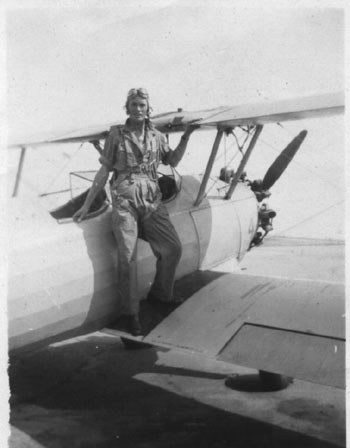
Lt Matthew S. Martin, 362nd FS
Martin & P40
I took advance training at Spence Field near Moultrie, Georgia (north of Tallahassee, Florida) in the AT-6. After completing advance training, our unit moved twenty miles southwest to Thomasville, Georgia. We had introductory training in the P-40 for a couple weeks. On the day of my first flight, I was walking to the Mess Hall when I noticed a particularly well worn bird that was identified as an AF 50 that had streaks of oil from the engine to the tail. I commented to a friend that I wouldn’t want to fly that plane. Later in the afternoon when I looked on the plane assignment board, you guessed it, I was assigned to AF 50. The mission for the day was to take off and climb to a 2,000 foot circle the air field and record the visible landmarks. My assignment was to repeat this process at 2,000-foot intervals until I reached 10,000 feet. All had gone well until I reached 10,000 feet. I was looking for additional landmarks when the weatherworn bird lived up to my misgivings. The engine cut out. Completely. I contacted the control tower and said, “This is Air Force 50 and my engine has just cut out. What should I do?” They responded, “Please hold we will contact Operations for instructions.” I responded to the tower, “Well you better not take too long…”. I decide not to wait too long, so I put the plane into a glide and prepared for a dead stick landing. After I landed the AF 50, the Operations Officer told the Crew Chief to pull the plane into its rightful place in the scrap yard.
My second emergency landing in a P-40 came a few weeks later in Sarasota, Florida. The flight was on my first day of dive bombing practice. The flight consisted of the Instructor, Lieutenant Miller, and myself. Lieutenant Miller had gone to the Operations Officer a few days before to ask to get out of flight training because he was afraid of the P-40. We were about 100 feet off the ground when my engine cut out, then caught again. I began a 180 degree turn and found that the engine would run OK at less than full power. I got the plane back on the ground and back to the flight line. (I later learned that my friend Jerry Jacobs was watching the show from the beach and had commented to a friend that there goes a poor bastard with a problem as he heard the engine cough and belch puffs of black smoke.). However, the problems were just beginning.
I had just got out of the plane and was explaining the problem to the crew chief when Captain Gosick, the Operations Officer, came running out of the Opps office. Lieutenant Miller had just gone in on the range and Captain Gosick wanted to fly out to look over the crash site. The crew chief suggested he take my plane. I told him of my experience but the crew chief said the plane was OK and the problem was cockpit trouble. Well, he jumped in the plane and I headed back to the Opps building. I was in the building for just a few minutes when we heard Captain Gosick call “may-day..may-day, my engine has just cut out.” Well he was also able to get the plane back on the runway. I walked back to the flight line. The Captain saw me as he was walking away from the plane and stopped for a brief conversation. He said, “only a fool would take off in a plane when another pilot had just reported engine trouble.” He promised me that he would let me know what had caused the engine problem. Later I learned that the mechanics found a restriction in an oil passage going to a main bearing. They guessed that under full power the bearing wasn’t getting enough oil and was causing the loss of power.
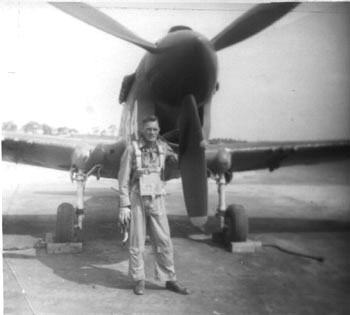
Lt Martin with the P-40
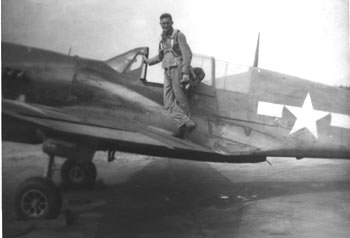
Lt Martin in training with the P-40
Some of our training could have been better, dive bombing instructions is a good example. Before going up on our first training flight the instructions we were given were:
fly over the target
as the target becomes visible behind the wing
roll over on your back and go into a dive
when the nose is lined up with the target pull the bomb release.
Nothing was said about speed or other flight parameters.
I scored a bulls-eye on my first mission, but I added a couple of steps to the procedure. As we approached the target we were a cursing speed. The first steps went fine, but as the nose of the plane came in line with the target I had so much speed that the centrifugal force made it impossible for me to pull the release the practice bombs. I pulled the plane up into a loop. By now I only wanted to get ride of the practice bomb, so near the top of the loop I pulled the bomb release handle. A few seconds later over the intercom came the instructor’s voice “nice bombing Red 4.” I looked down to see a cloud of dust blowing away from the center of the island.
A story Dad told as described by a pilot attending Clobber College. ( a training program set up for new pilots coming into the 357 after October or November 1944). OBee O’Brien was the instructor. A student ask what should he do if he saw a German on his tail getting ready to fire. OBee said, “apply full throttle, apply hard right rudder, and pull back on the stick.” The airman said, ” and then what next.” OBee replied, “dammed if I know, but when you recover from that maneuver the German won’t be behind you.”
Thanks to Matthew and his son John for this great story and photos!!
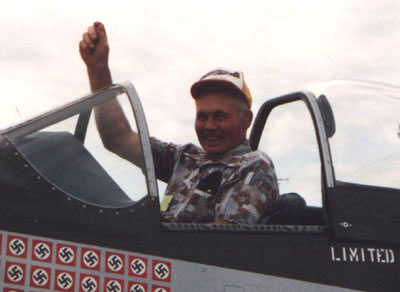
Matthew Martin in the cockpit of a restored P-51
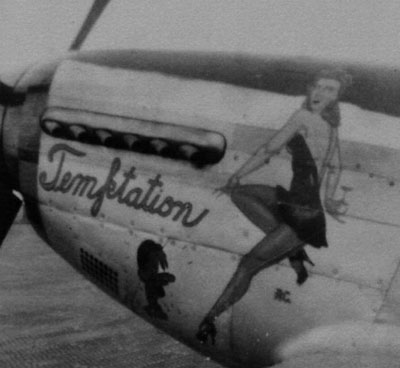
P-51D, 44-17422, G4-N, “Temptation” – Lost in this a/c 5 Dec 44 – POW, MACR 10808
From Merle Olmsted’s Book The 357th FG Over Europe Reprinted courtesy of Merle Olmsted and Specialty Press.
First Lieutenant Matthew “Smilin’ Jack” Martin was 362nd Squadron’s mail censoring officer on the 4th ( 4 Dec 44) and too busy to fly that day. The following day Martin was Officer of the Day and would not fly again. However, he went to briefing with his buddy, Willie Gilbert, and here he found the Mustangs were going straight to Berlin. This was too good to miss so he had a new replacement pilot take his OD duties for him.
In retrospect, Jack Martin should have served his twenty-four hours as OD.
The mission was logged off at 0837. The first two hours were a sight seeing tour across the Low Countries then into Germany., Then, with the B-17s approaching the IP (Initial Point) some one called out, “Bandits ahead.”
Martin remembers:
“I checked gun heat, gun sight, and was as ready as a ‘dog at the edge of a brush pile.’ I was flying element leader on John Kirla’s right wing when suddenly a spray developed out of his vent pipes. The fuel and coolant vent pipes are very close together so I moved in under Kirla very close to check. It was fuel and I told him to switch tanks. When I said, ‘tanks’ my engine quit and caught fire. Kirla told Red Two (Gilbert) to stay with me. I was on fire, so told Red Two to stay with the flight as I was getting out.”
“I dived through 4,000 to 5,000 feet of overcast and when I broke out, the airspeed was ‘in the corner” – too fast to bail out. I pulled the nose up to slow down and it was back into the overcast. It was getting hotter and fumes were coming through my oxygen mask – to get out, so I rolled upside down. During the dive I had a lot of pressure on the left rudder and when I released it to fall out, the airplane did a violent half roll pinning me in the cockpit. Pushing with both hands I managed to get out and then my right thigh hit the stabilizer.”
After a very long fall Martin landed in some trees. Although not captured upon landing his rapidly failing leg caused him to surrender and he was on his way to Stalag Luft I via the same route trod by thousands of other Allied flyers. Along with many others he was released in April 1945 by advancing Russians.
John Kirla whose venting fuel problems started the sequence of events, went on to shoot down an Me 109 and an FW 190.
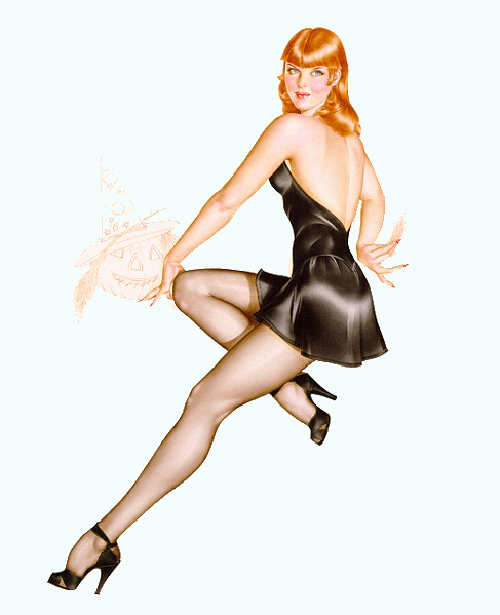
Vargas Girl used for the nose art on Matthew’s Mustang

Beautiful print of Temptation by John “Wily” Mollision

